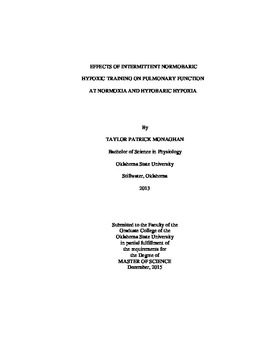| dc.description.abstract | This study investigates whether 6 weeks of intermittent normobaric hypoxic training (INHT) elicits improvements in maximal oxygen uptake (VO2max) or various measures of pulmonary function. Training under hypoxic conditions has been suggested as a way to improve endurance performance at sea level and altitude. This is possibly beneficial for the military, as situations occur where personnel are quickly deployed into areas of high altitude without sufficient time for acclimatization. Therefore, 10 highly trained male members of the Army or Air Force Reserve Officers� Training Corps (ROTC) performed maximal treadmill tests in normoxia (FiO2 - 20.9%, 744.0mmHg, PO2 - 155.5mmHg) and hypobaric hypoxia (HH) (FiO2 - 20.9%, 536.7mmHg, PO2 - 112.2mmHg). Forced vital capacity (FVC), forced expiratory volume in 1 second, (FEV1), and peak expiratory flow rate (PEF) were also measured prior to treadmill testing with a portable spirometer. After pre-testing subjects were split into experimental (EXP), INHT (n=6) or control (CON), normoxic training (NT) (n=4) groups and started training 3 days per week, 1 hour sessions. The INHT group trained using normobaric hypoxia (FiO2 - 14.7%, 744.0mmHg, PO2 - 109.4mmHg). Intensity of training was progressively increased to prevent under or overtraining and was based on maximal heart rate (MHR) achieved during their respective VO2max test. Post-testing revealed a lack of significant changes in VO2max, FVC, FEV1, or PEF between or within groups due to INHT or NT. Although, when percent increase was calculated the EXP group significantly improved in HH VO2max compared to the CON group (p < 0.05). Also, combined VO2max scores were able to show significant improvements at HH and normoxia. Furthermore, combined spirometric measures for FVC significantly decreased at HH, while PEF increased. These results are favorable for military implementation to increase endurance in personal who are quickly deployed into altitude. In addition, the training program implemented did prove to be effective for using INHT within current physical training. Lastly, despite a change in pulmonary measures due to training, FVC and PEF were sensitive to changes in altitude and may be beneficial in detecting the onset of acute mountain sickness (AMS) or high altitude pulmonary edema (HAPE). | |
